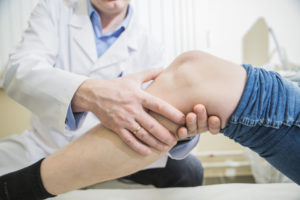Those that remember the 1999 Baz Luhrmann song, ‘Everybody’s Free to Wear Sunscreen’, may recall the sage advice it offered; “be kind to your knees, you’ll miss them when they’re gone”. Our hips, knees, and legs take a great deal of impact over our lifetime. Estimates vary, but it is thought that the average person walks in the region of 7,500 steps per day, which equates to over 100,000 miles by the age of 80. And it is only when we find ourselves injured, perhaps due to overuse or trauma, we realise how much we have taken our lower limbs for granted.
What are lower limb disorders (LLDs)?
In previous articles, we have discussed the very common problem of occupational musculoskeletal disorders (MSDs). MSDs are injuries affecting any part of the human musculoskeletal system – including the bones, joints, ligaments, tendons, nerves, cartilage, that make up the neck, back, and limbs. Lower limb disorders (LLDs) are a subset of MSDs which specifically affect the region between our hips and our toes. And as if two acronyms weren’t sufficient, when this type of the injury occurs in an occupational setting, the Health and Safety Executive (HSE) use the term Work Related Lower Limb Disorder (WRLLD). 
LLDs are characterised by inflammation, pain, discomfort, or tingling in the site of the injury . According to the HSE, there are two broad categories of the injury, acute and overuse. In its acute form, those affected may have tears (e.g. in knee cartilage), or bone fractures (e.g. in the foot or ankle). Overuse injuries in the lower limbs typically show themselves as:
- Osteoarthritis
- Stress fractures
- Hamstring strains
- Patellofemoral pain syndrome
- Shin splints
- Achilles tendonitis
- Plantar fasciitis
- Ankle sprains
- Varicose veins
In the year 2016/17, the HSE’s Labour Force Survey found that there were 84,000 cases of WRLLD, which equated to 1.8 million of lost working days, or 21.1 days per case.
What can employers do to prevent LLDs in their workplace?
The Health and Safety at Work etc Act 1974 places a legal duty on employers, “to ensure, so far as is reasonably practicable, the health, safety and welfare at work” of their employees. In practical terms, this means that they must assess the workplace for any risks to health and safety, and then seek to completely remove the risk, or reduce it to an acceptable level. Thankfully there are a wide range of very effective measures that can protect employees from injuries to the lower limbs.
Personal Protective Equipment (PPE)
PPE can be used to great effect to prevent both injuries caused by trauma, or by long-term overuse, especially where an identified LLD risk has been found but cannot be fully removed. One such example is safety footwear, which in the event of an object falling onto the foot can prevent potentially serious foot and toe-crushing injuries. Knee pads can also be used to mitigate serious penetrating injuries to the legs. And anti-fatigue matting is commonly used to reduce the prevalence of stress injuries which are caused by standing for long durations.
Redesigning of work tasks and environment
Often even the very simplest of changes can make work tasks safe from the risk of damage to the lower limbs. Those assessing risks to employees could consider:
- Moving workers between different tasks help to minimise the likelihood of an LLD
- Redesigning the workplace, e.g.:
- Completing the work in a seated position
- Installing a guard or protection be added to prevent injuries to legs
- Removing the need for excessive physical movement in a given work task, such as rotation, bending, or kneeling – perhaps by rearranging a workstation
- If lifting a heavy object, can this be done with assisted lifting equipment?
- If lots of walking is necessary for a particular role, can the route be organised to reduce the distance required
- For drivers who need to jump down from their cab, to the floor, can a step be provided to reduce the impact to their hips and knees?
- Removing the potential for trip hazards
Claiming for compensation
Lower limb disorders, while not necessarily life-threatening can cause significant pain, distress, an inability to work, and you may be unable to carry out simple everyday tasks for many weeks or even months. If your employer failed to ensure your health and safety, you might be entitled to a compensatory award to cover the physical and psychological suffering you have experienced, in addition to the financial expenses and losses you have incurred. To make a claim, the accident (or date at which you were aware of a lower limb injury) will need to have occurred in the last three years.
By engaging our team of highly experienced workplace personal injury solicitors, we will work to prove that your employer is legally accountable for the accident. If you are unsure if you have a case, contact us today. We will take the time to understand the details of what happened and give you a clear and objective assessment of your legal position with regard to claiming compensation.
At Russell Worth Solicitors we specialise in personal injury claims. If you have suffered a workplace injury and would like a free claim assessment, please call us now on 0800 028 2060 or complete our Online Claim Assessment.

